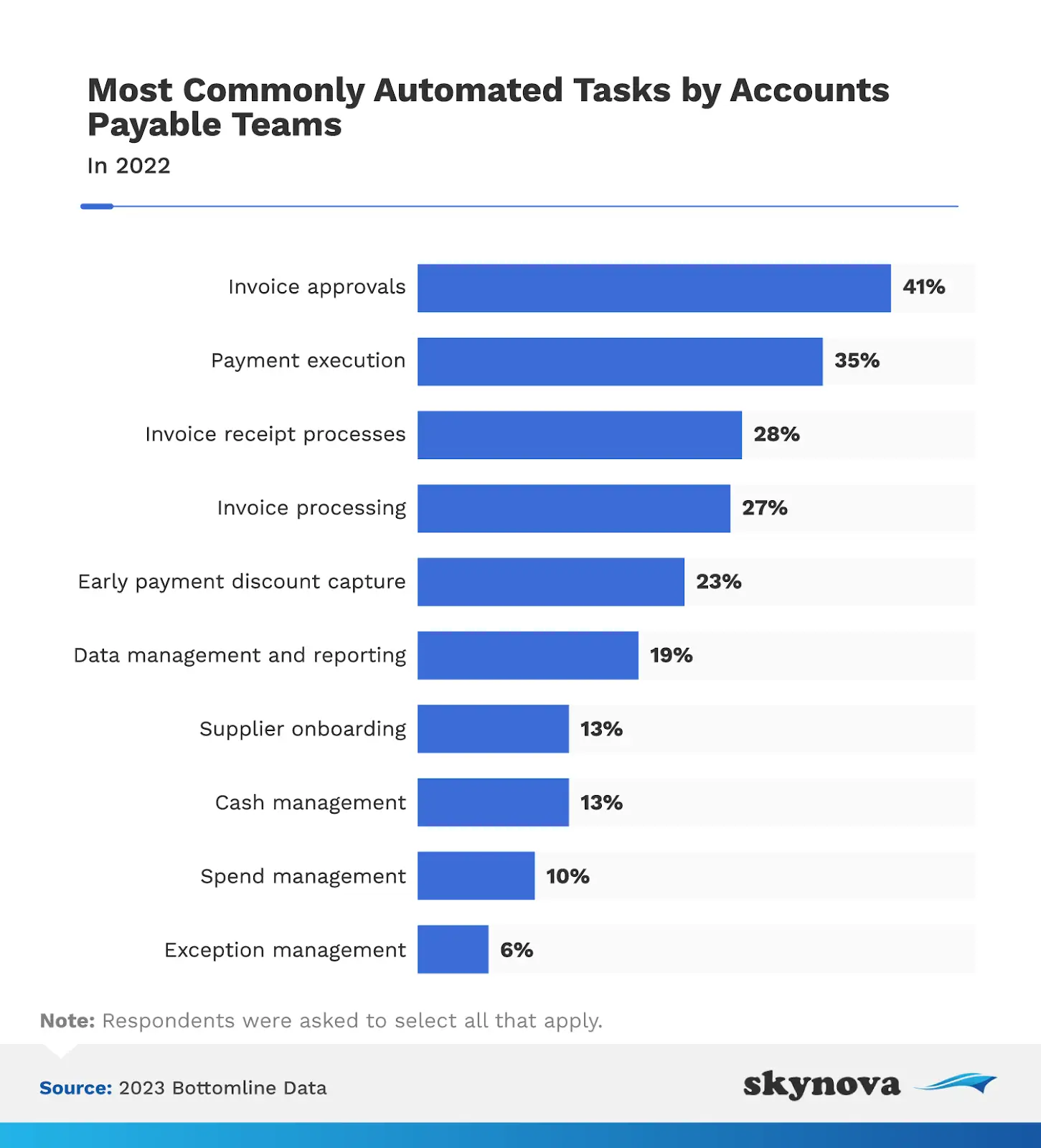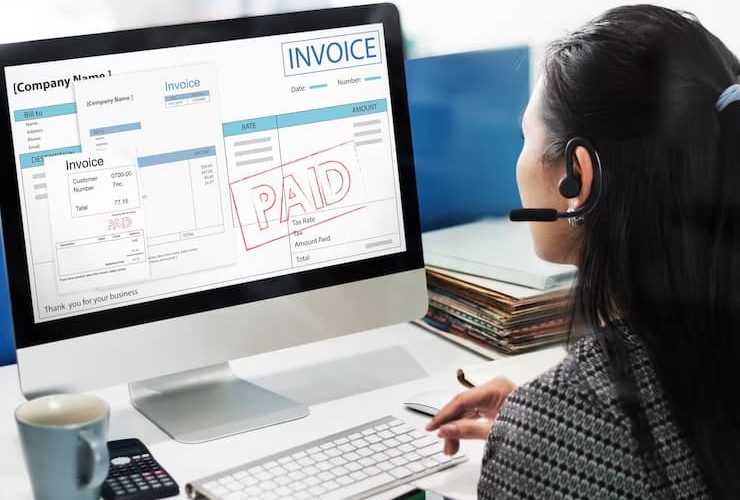Vendor invoice management sounds like a mouthful, but it’s really just a way to make sure you’re paying your suppliers correctly and on time.
But it’s not as simple as it sounds.
Almost more than 500 invoices are processed each month, which takes an average of 5 days. Each invoice may involve 2-3 people until it finally passes the approval process. It’s a long process that takes time and resources and, if not done correctly, is prone to errors that ultimately disrupt supplier relationships, the procurement process, and cause poor cash cycle flow.
Different businesses operate on different models. Many businesses process their invoices manually (57%), while 37% send paper invoice receipts, and 52% send electronically (via email). While only 5% of the accounts payable team use a fully automated process.
But with the increasing benefits of cost and time, companies are moving toward automation.

According to Levvel Research, manually processing invoices costs $10 to $15, while some said it might cost up to 16%. However, with automated vendor invoicing, businesses can cut costs as low as $3. In this way, businesses can save a lot on operational costs with a single automation.
In this blog, we will learn about vendor invoice management and how proper invoice management can save costs.
What is vendor invoice management?
Vendor invoice management (VIM) is the system your business uses to receive, review, approve, and pay supplier invoices. It ties directly into your procurement and accounts payable workflows.
Let’s say you order 500 units of product from a vendor. They ship the goods, and then send you an invoice. Your job is to verify the invoice matches what you ordered (cross-check with PI) and received, get it approved, and make sure payment goes out accurately and on time. That entire journey from receiving the invoice to issuing payment is vendor invoice management.
In wholesale and distribution businesses, this can get complex fast, especially when dealing with international suppliers, varying terms, or bulk discount structures.
Why it matters for wholesalers and distributors
When invoices pile up or go unpaid, your supplier relationships suffer. Worse, if your team misses details or duplicates payments, you end up losing money. According to Ardent Partners’ 2024 State of ePayables report, over 38% of invoices are still received in paper format, while 62% are received in email format, increasing the chance for manual error.
Late or inaccurate payments can also affect your credit terms and disrupt your supply chain. That’s why having a streamlined invoice management process is so important, especially in high-volume environments like wholesale.
Information on the vendor invoice (Supplier perspective)
The information on a vendor invoice might vary depending on your business and vendor type. Are you sourcing raw materials or finished goods? But the following information is universally considered on a vendor invoice.
Invoice date
The date mentioned on the invoice represents the date the invoice was created. The due date will be mentioned on the invoice – the date when the invoice is supposed to be clear. If the invoice says 15 days, the invoice is supposed to be clear in 15 days.
Invoice Number
It’s a unique identifier mentioned on the vendor invoice. Every invoice is given a specific number, making it easy for the sender and receiver to record manually or in their system.
Contact information
Your vendor invoice should include all the information related to the supplier (Sender) and the organization (receiver) – name, address, email, website, etc.
Description of goods or services
Your invoice should contain all the information related to the product being delivered, including the number of products, their names, the amount related to each, color (if required), weight, or any other additional details.
Payment terms
To maintain a healthy cash flow, always try to use payment terms that clearly mention how many times or until the payment should be clear. Use terms that encourage early payment. This is equally beneficial for the sender and receiver as it clears the air about what is supposed to be done without being vague and questioning things.

Amount due
In the end, make sure to add the net payment due – any sales tax or additional cost must be mentioned in the last to maintain transparency.
The Vendor Invoice Management Process
Here’s how the process typically works in a B2B setting:
- Invoice Receipt
Invoices come in via paper, email, EDI, or vendor portals.
- Invoice Matching
Match the invoice to the related purchase order (PO) and goods receipt.
This is often called 3-way matching (PO, invoice, and delivery confirmation).
- Approval Workflow
The invoice is routed for approval based on amount, department, or project.
- Payment Scheduling
Once approved, the invoice is added to the payment queue based on due date and vendor terms.
- Payment Processing
Payments are issued by check, ACH, or other preferred method.
- Recordkeeping & Audit trail
The transaction is logged and stored for accounting and audit purposes.
The cleaner and more automated it is, the smoother your cash flow and vendor relationships will be.
Top Challenges Businesses Face in Vendor Invoice Management
Despite how basic it sounds, invoice management comes with plenty of headaches:
Manual data entry:
According to research done by Endava, 86% of SMEs still manually enter invoice data. But the problem with manual entry is that you could face typos and payment errors.
Several studies and research showed that businesses that heavily rely on manual invoicing – creating, approvals, and payments – take 3x-4x more time and cost than those that use automation for these processes. Therefore, 26% more businesses are now considering a manual-to-automation shift.
Delayed approvals
If you are running a business where the average number of invoices you receive is more than 500–600 per month, then not having a proper automation or management system can lead to missed payment deadlines. How? Suppose you receive 250 invoices via paper and 250 by email. At the end of the month, you first have to collect and identify the invoices, then enter that data one by one into your system. This process can take several days. And if, by any chance, you miss an invoice or enter incorrect data (even a minor error, like a misplaced zero), your entire process will need to be reviewed, delaying final approval and, ultimately, the payments.
Duplicate or fraudulent invoices
If you receive multiple invoices and do not have enough time to cross-check each one with the purchase order, you might skip it if a vendor sends multiple invoices or the amount is incorrect. Without proper checks, your whole system will become faulty.
Lack of visibility
The main problem with the manual invoicing system is the lack of visibility. When you don’t have a system to check in which stage the invoice is in, it makes it hard to track the invoice status. Whether it got approved, is still being processed, or if the specific vendor gets its payment in due days, you may face supplier disruptions.
Compliance issues
Compliance issues arise when your records aren’t audit-ready or tax-friendly. You cannot audit or manage your taxable income without visibility on the exact amount you paid.
How Automation Solves These Problems
Several automation tools are available on the market to help vendor invoice management at all stages.
- OCR (Optical Character Recognition) tools read invoice data automatically.
- 3-way matching software ensures invoices are only paid if they match the PO and goods received.
- Approval workflows become faster with digital routing and real-time alerts.
- Dashboards provide real-time visibility into invoice status and payment timelines.
- ERP or accounting system integration keeps records clean and synced.
How to choose the right invoice management software
| What to consider | What to look for | Top tools | Why are they good |
| Automation | OCR accuracy, less manual work | Brex, Docsumo | High accuracy in reading invoices automatically |
| Integration | Works well with popular accounting and ERP systems | DATABASICS, Tradogram | Connects easily with systems like SAP, QuickBooks |
| Security & Compliance | Keeps data safe, supports audits | Bill.com, DATABASICS | Strong security and audit features |
| Scalability | Handles many invoices and multiple currencies | Brex, Corcentric | Supports large volumes and global payments |
| Ease of Use | Simple interface, easy to learn | Monday CRM, FreshBooks | User-friendly with mobile access |
| Cost | Affordable pricing, clear ROI | Tradogram, Xero | Low cost per invoice and flexible plans |
| Support | Good customer service and help during setup | DATABASICS, AvidXchange | 24/7 support and expert guidance |
| Customization | Flexible workflows and options | Stampli, Docsumo | Can be tailored to your company’s needs |
| Reporting & Analytics | Real-time insights and spending reports | Brex, Tradogram | Helps track payments and forecast cash flow |
| Industry Focus | Special features for specific sectors | Bill.com, Corcentric | Templates for healthcare, retail, and manufacturing |
Conclusion
Wasting time on manual work that is prone to error and can be done more efficiently using automation is a curse for any business looking to scale. Supplier/vendor relations are crucial for any business because delayed payments can cause many concerns. Some vendors add a contract clause where persistent delayed payments can breach the contract, but it also depends on the supplier and customer relations if they tolerate or cancel.
In both scenarios, it’s not professional for any business to persistently miss due dates, if not under any circumstances. Therefore, businesses are considering automated vendor invoice management to prevent these situations and be more operationally and financially efficient.



